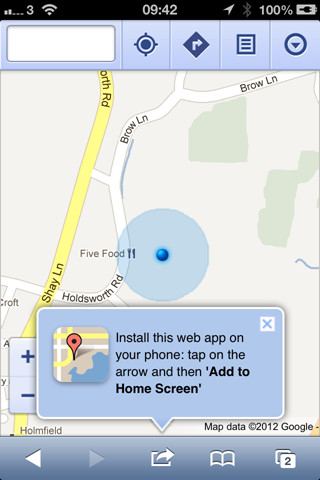So, you've either bought the brand new iPhone 5 or have upgraded your existing iPhone to iOS 6 and discovered, like half the Internet it would appear, that the new Apple Maps which have replaced Google Maps are, to be polite, an utter and total stinking FAIL. I'm no Apple hater, in fact quite the opposite as I own and use an iPad 2 and an iPhone 4S on a daily basis. However, I'm not so much of a fanboy that I cannot call it as it is when Apple gets things very wrong indeed.
 Thankfully, having fallen into the latter category and upgraded my iPhone 4S to iOS 6 (which I actually think is rather splendid apart from the godawful maps fiasco) I have found a very simple method of undoing the damage and getting fully working maps back for the iPhone while I wait for Apple to fix things. But more of that in a moment, first though let's take a look at just what exactly has gone wrong.
Thankfully, having fallen into the latter category and upgraded my iPhone 4S to iOS 6 (which I actually think is rather splendid apart from the godawful maps fiasco) I have found a very simple method of undoing the damage and getting fully working maps back for the iPhone while I wait for Apple to fix things. But more of that in a moment, first though let's take a look at just what exactly has gone wrong.
The problem with the Apple Maps app can be summed up in one concise phrase: not fit for purpose. It has all the look and feel of a Beta test rushed into production before it is ready, and certainly before it has been properly tested. I mean, what is the sole purpose of a map application? Yep, that's right, showing you where you are and where places you might want to get to are in relation to that. You might be one of the lucky ones who only ever happens to be somewhere that Apple Maps has managed to get right. Given the number of truly incredible omissions and errors being reported online, I imagine that's pretty unlikely though.
Apple Maps, for example, thinks that the flagship Apple Store in Sydney Australia is located in the flagship store of telecom giant Telstra. But that pales into the almost acceptable when you discover that Gothenburg no longer exists in the satellite view of Sweden, the city of Hong Kong is no longer on Hong Kong Island, Paddington railway station (one of the busiest in London) has been erased along with Tokyo station in Japan and Helsinki railway station in Finland is shown as a park, Dublin in Ireland gets a new airport that doesn't exist. I could go on, but I won't as there are just way too many errors to report here.
Somewhat ironically, I use the TomTom satnav app on my iPhone and this continues to work as expected so I am not in danger of getting lost in my travels. I say this is ironic because much of the mapping data for the Apple app was provided by TomTom itself. The Dutch satnav giant has been quick to distance itself from the problems though, insisting that it just provided raw mapping data and how well, or badly, Apple turns this into a working application is nothing to do with them. Replacing a free mapping app with an expensive commercial satnav mapping solution is, frankly, no solution at all for anyone who doesn't already own it.
So what is this simple fix for the Apple mapping fail mentioned at the start of this article?
That, dear reader, is to go back to using Google Maps instead. Now I know what you are thinking, you cannot roll back iOS upgrades (or individual app upgrades for that matter - another Apple fail, but don't get me started on that particular rant) so how can you return to the now banished Google Maps App? Well, you can't as such, but the briefest bit of logical thinking reveals that you can use the Safari browser to access Google Maps on the web, and you can take up the offer that kindly appears when you do so to let it install a Google Maps icon on your iPhone home page so that you can get back to it with a single click next time. You know what, that works for me. At least until the iOS 6 ready version of the Google Maps app, which I understand is 'waiting approval' for App Store release, becomes available. Or should I say, if it ever becomes available. Apple has a bit of a history of delaying or simply refusing the distribution of apps which compete directly with their own brand operating system included ones. Let's just hope that this time it sees sense, and puts the consumer first.
Apple Maps is quite plainly not ready for the big time, and needs to go back to the labs to get properly finished before being considered as suitable for real world use. In the meantime, Apple needs to eat some humble pie and allow Google Maps back to play...
